Beyond all the blog posts I did this year covering my Amiga system upgrades, many new games and other programs like AmigaOS 3.2 and PiStorm hardware released in 2021, I also decided to spend some time finding and trying out software and games in 2021 that I have never tried before on Amiga.
This included not only new games, hardware and applications released in 2021, but also historical software and hardware I never got to try out like Deluxe Music 2, Twist 2, DesignWorks, AMOS Pro, ProWrite, Professional Calc, or software I never owned the original boxed software and manuals for, like Final Writer and Final Copy II.
As anyone here who regularly follows Ebay would know, many popular boxed Amiga games and applications are becoming seriously expensive to buy on Ebay now. To get this software I tried to avoid paying too much, with varying degrees of success!
I remember buying AMOS 1.3 back in 1991, but could never afford the AMOS Compiler, AMOS 3D or AMOS Professional later on. I was glad to finally pick these up this year, and install them on my Amiga 3000, newly rebuilt this year and now working well.
I put AMOS 1.3, Compiler and AMOS 3D on the AmigaOS Workbench 1.3 partition, and AMOS Professional on the AmigaOS 3.1.4.1 partition on the A3000:

Having now installed them both, I can say for sure that the AMOS hard disk installers are awful.
That said, I like the idea of developing some software on AMOS in the future. Recent
add-on tools like ALS have got me interested in doing something new with it. Need a lot more time than I have at the moment though!
I also picked up a local Australian made Amiga sound sampler and Audio Engineer software to try out on the Amiga 3000 too!

On the subject of sound, I also got into MIDI using a Roland SC-88 connected to my Amiga 3000 running Sequencer One Plus, which I managed to locate this year and loved listening to!
I used to use Sequencer One (the full version released on Amiga format cover disk) on my Amiga 2000 back in 1991 to play MIDI through our Roland MIDI Piano. It is great now to have the Plus version with the extra channels and other features.
I have played with Page Setter desktop publishing before, as my Dad bought it for our Amiga in the late 1980's, but I never realised just how much other software Gold Disk made for the Amiga! I found and tried out Professional Calc 2, which is quite impressive Spreadsheet software for the Amiga:
Beyond Deluxe Paint, Deluxe Music 1 and 2 was also a popular program on the Amiga, but I never used it until now because my music work had been in MIDI (Sequencer One) or module trackers like Protracker and Octamed on the Amiga.
I have only scratched the surface with it so far. Deluxe Music 2 is very cool software, and I plan to spend more time mucking around with it.
Having the manuals for these applications makes it much easier to learn all the features of the software that is for sure!
I also located and mucked around with DesignWorks this year. I was surprised how much application software there really was on the Amiga. It is a timely reminder that the Amiga is definitely not a games machine only - it can do so much more than just playing great games.
I used to use Photogenics 1.0 from the cover disk version supplied back in the late 1990's for graphic editing to replace Deluxe Paint IV, but in 2021 I was able to find a newer version Photogenics 2 CD boxed release. I know there were later HDR versions released too, but not as a boxed product, and I missed the opportunity to buy it from the (now gone) web site.
Speaking of Deluxe Paint, I was lucky enough also to find a boxed Deluxe Paint V, which I have never owned before and is quite hard to find boxed like this. I already had Deluxe Paint IV AGA, and it was nice to have the final version 5 of the most famous paint program on the Amiga, released in 1995, well after Commodore went under!

There is also a modern CD version of Personal Paint, available for purchase in 2021 from A-Eon (AmigaKit) for Classic Amiga systems, and also on PowerPC AmigaOS 4 computers.
I already had the AmigaOS 4 version, but this year I picked up the newest Personal Paint for Classic Amiga to try it out.
Just to prove that not all application software is in Amiga's past - we have modern applications for sale still in 2021!
Some final older applications I found this year was Pixel 3D 2 graphics package, and Twist 2, which is a database program. I already have Superbase Personal Database software for the Amiga, but Twist 2 was released much later in the mid 1990's, and I had never heard of it!
Moving away from applications now, there were a lot of games I missed out on for Amiga, especially between 1994-1996 when I didn't have an Amiga to use, and it has been fun in 2021 to finally try some of these out too!
Buying original boxed old games and applications in 2021 for the Amiga really is a lottery - the disks might work, or they might not.
Important part I think it not to pay too much for them, then it is not as disappointing if they don't work. Fortunately for me, only a handful of game floppy disks had gone bad.
Is it just me or is it scary that Impossible Mission 2025 is now only just over 3 years away?
I bought Impossible Mission 2 for Amiga 500 back in the late 1980's, played Impossible Mission a lot on the C64, but have never played Impossible Mission 2025 before this year!
I also never realised how prolific Core Design was in game releases on the Amiga in the period after Commodore went bankrupt. Some of these games are very good indeed, and I am glad I got to try them out in 2021.
Blob was an interesting game, but much harder than I first thought! I tried it out on the CDTV but the infrared CDTV controller is not great for this kind of game to be honest!
I have to say that postage costs skyrocketed in 2021, and shipping items to Australia became extremely expensive as a result.
Once you added Ebay's "import costs" on top of GST payable for importing a second hand item (!), a game that was bought for $12 on Ebay cost over $50 delivered. A game that costs $40 ends up costing over $100 delivered!
This ridiculous situation meant I needed to combine shipping as much as possible and minimise the number of different sellers I bought from, to minimise the profiteering antics of Ebay's "Global ripoff shipping program" and the government in Australia charging 10% GST on second hand items on top....it was definitely challenging.
I tried to find items locally where possible to avoid these costs - I got a large shipment of heavy boxed Amiga applications outside Ebay from a seller in Tasmania, which saved me a lot of money trying to ship the items from overseas.
Back to the games though. I am a huge fan of Wizball, but I never actually played the sequel Wizkid! It is an interesting game, but I still prefer the original C64 version of Wizball. The Amiga version of Wizball was good, but the music was not a patch on the beautiful SID music of the C64 version.
I am also trying out Reunion and Seek and Destroy, two more games I have never even heard of, released after Commodore went under.
I enjoyed playing Vision's Roadkill AGA game back in the day, but this game from them I didn't know about. It is quite fun actually!
It has been a lot of fun this year re-discovering my Amiga, discovering a world of applications and games I never used before 2021!
On top of all this, I am currently working on a new mobile streaming setup using my old Alienware 15 R3 laptop when I occasionally get time, and hope one day to be able to use it to more easily stream live from my favourite computers.
I dabbled with it last year with the AmigaOne X1000 and some streams from the Raspberry Pi400 and Amiga 1200/4000 for demos, but setting up streams for older computers from my main machines is very time consuming, pulling apart and setting up my machines in another room, which put me off doing more streams with my systems.
I have high hopes for this new setup, which is more easily able to move between computers with minimal recabling. I have it working well now on the Amiga 3000, C64 and Pentium 200 MMX systems and will continue to work on getting it working well with more systems.
One last thing I have been working on recently with my recently purchased Amiga 600, is a scan doubler solution for it's video output for TFT screens.
Originally I had planned to put a RGB2HDMI solution in it. I bought a 'built and configured ready to run" solution, and installed it, as below:
There were no instructions included so I looked online for how other people did it.
With the Mini-HDMI converter and HDMI plug attached, it pushes down harder on the keyboard connector than I would like..
Unfortunately the RGB2HDMI solution didn't work at all - nothing outputted to the screen. Worse still, it started causing stability issues for the Amiga 600 with it attached, with red screens and other issues I had not seen until I attached this solution to it.
I pulled it out before it did any lasting damage. I then decided to buy a Indivision ECS v3 from Individual computers for the A600 instead.
I previously had a Indivision ECS connected to my old (failed) A600, but I moved it to the A3000 when it's native output started having issues, and so I no longer had one for this A600.
When the new Indivision ECS v3 arrived, I was irritated that the instructions included no information on how to install it in the A600. When I checked online for the instructions, it just said "same as per V2".
The problem I quickly found was that the Indivision ECS v3 is far too tall to fit on the A604 and still be able to close the A600 case.
This seems a very obvious design flaw in the Indivision ECS v3....I show the gap with the top closed over the top below. Why say the v3 works on the A600 then?
After reading a bit closer on the Indivision ECS V3 product page (not the instructions) I found this:
With A604 or A604n, the bottom cover will have to be left open, otherwise the keyboard will not fit.
Right...why couldn't this be stated in the instructions included with the product?
Anyway, I found a solution to the problem. I opened my Checkmate 1500 plus A500 system case, and swapped it's older version Indivision ECS for the new Indivision ECS v3...the Checkmate A1500 case has plenty of room...
I then put the old Indivision ECS board in the A600:
My old A600 had the RF modulator slot de-soldered by a colleague a few years ago, but this new A600 does not have that, and I lack the desoldering skills needed to remove it myself.
For now I fed the VGA output through the Gotek hole that normally contains the LED screen (which is on top of the A600 instead), to feed out the VGA connector via the floppy drive slot.
The TFT screen output on the A600 is now great with the Indivision ECS in place. Very happy.
I enjoyed some clean scan doubled outputted demos on my A600 to celebrate!
With my Amiga 3000, Amiga 600 and Amiga 1200 all running well now, I think I will leave them alone for a bit upgrade-wise, and just enjoy them as they are. Heh, I almost laughed when I wrote that. We'll see how long that lasts...
I hope this blog entry and all the ones I wrote this year have been interesting! I am not sure if there will be any further blog posts before the end of the year, as my wife and I will take a well earned break from work at the end of this week to spend time with family and do non-computer related things for a bit.
So, I hope you and your family have a great Xmas and New Year, and I look forward to more blogging about computers on my return in 2022!

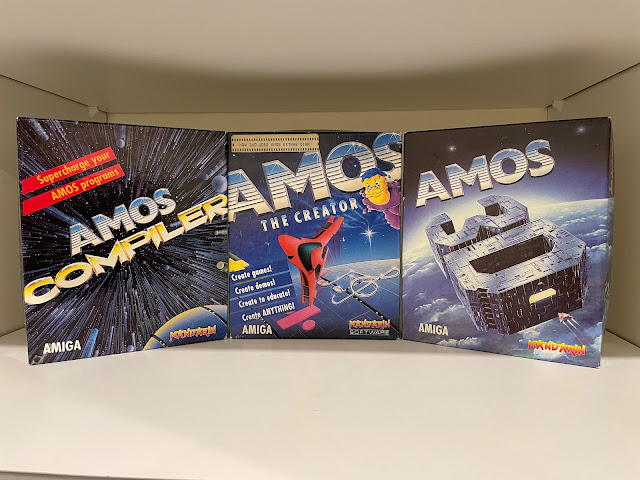


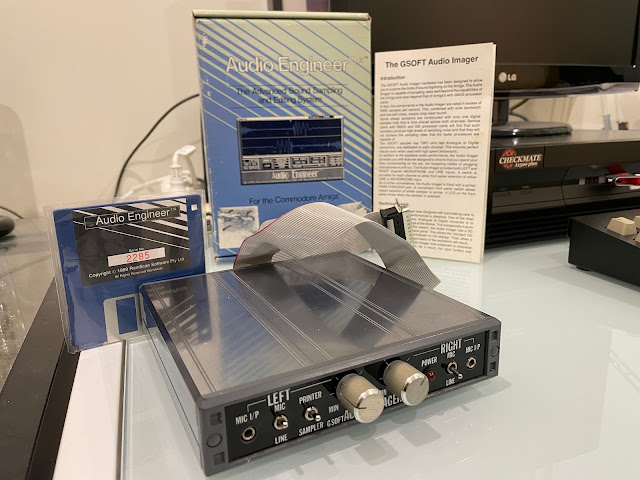





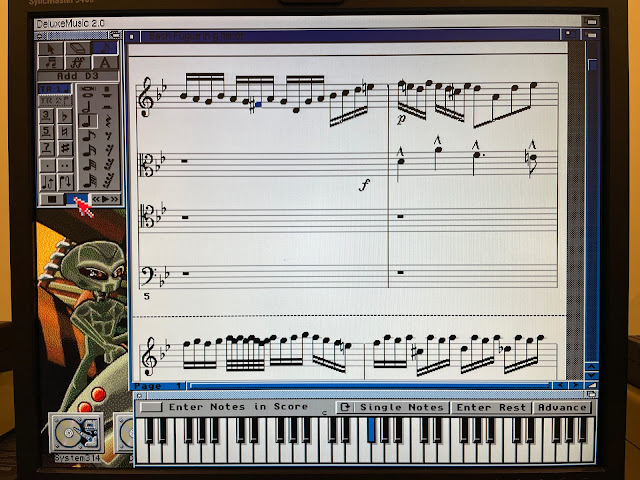






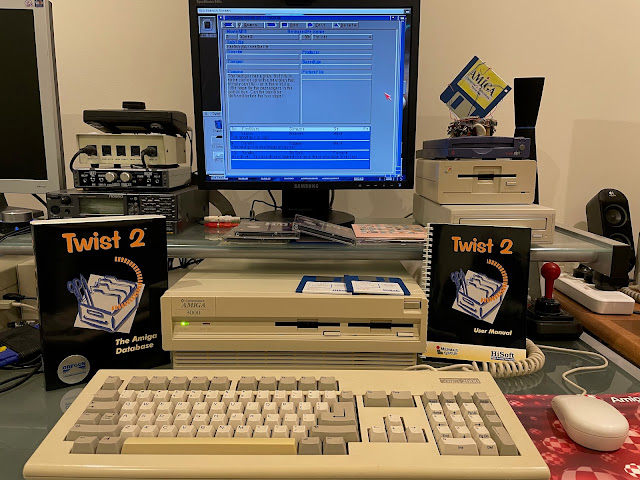


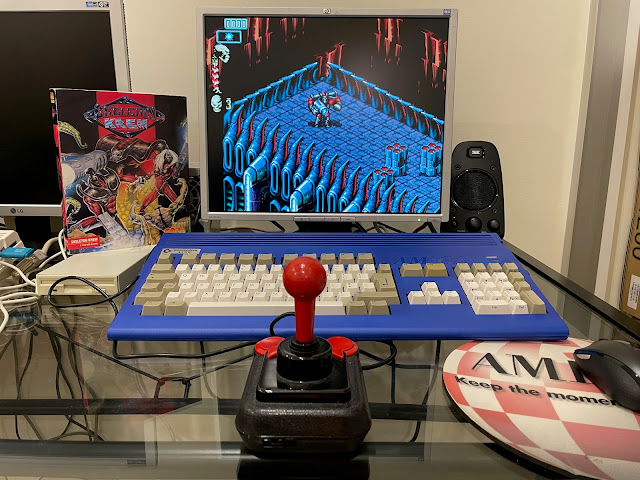







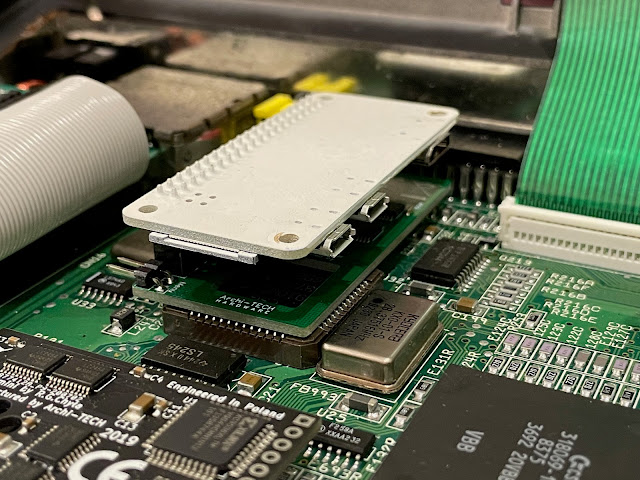


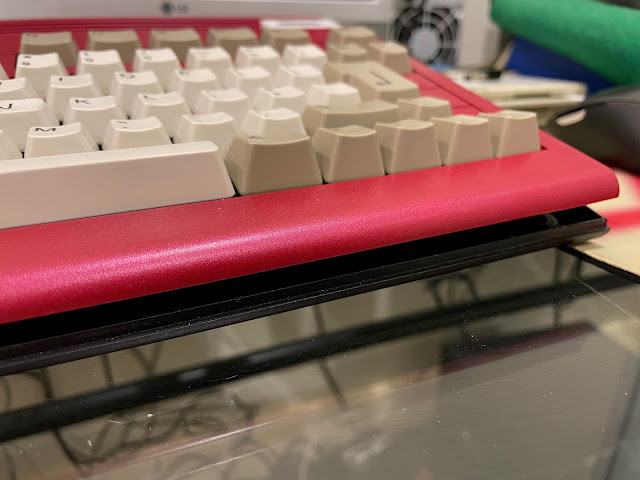

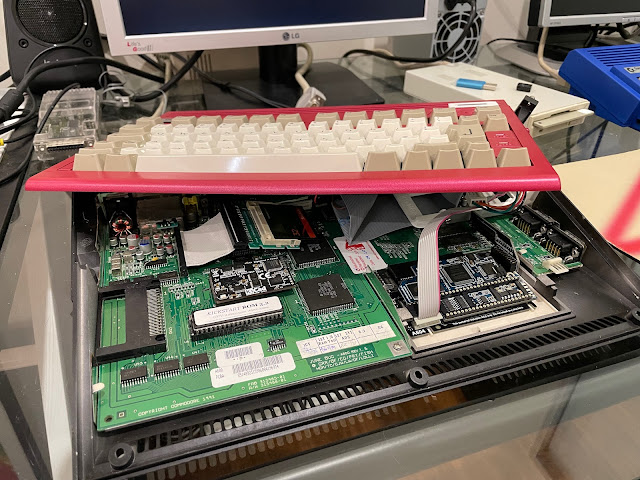
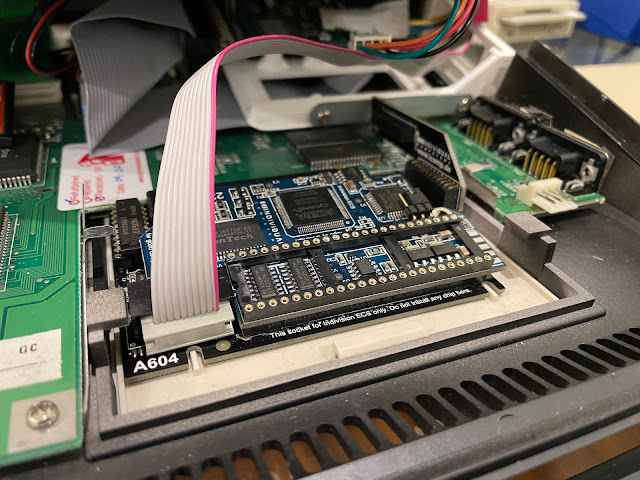




Great stuff with the A3000. I have one with a Mac Shapeshifter partition but have never really used it, preferring an A1200 for Whdload and music, graphics. Nice to see you're capable of being productive with the Amiga platform. Great blog. Thanks.
ReplyDelete